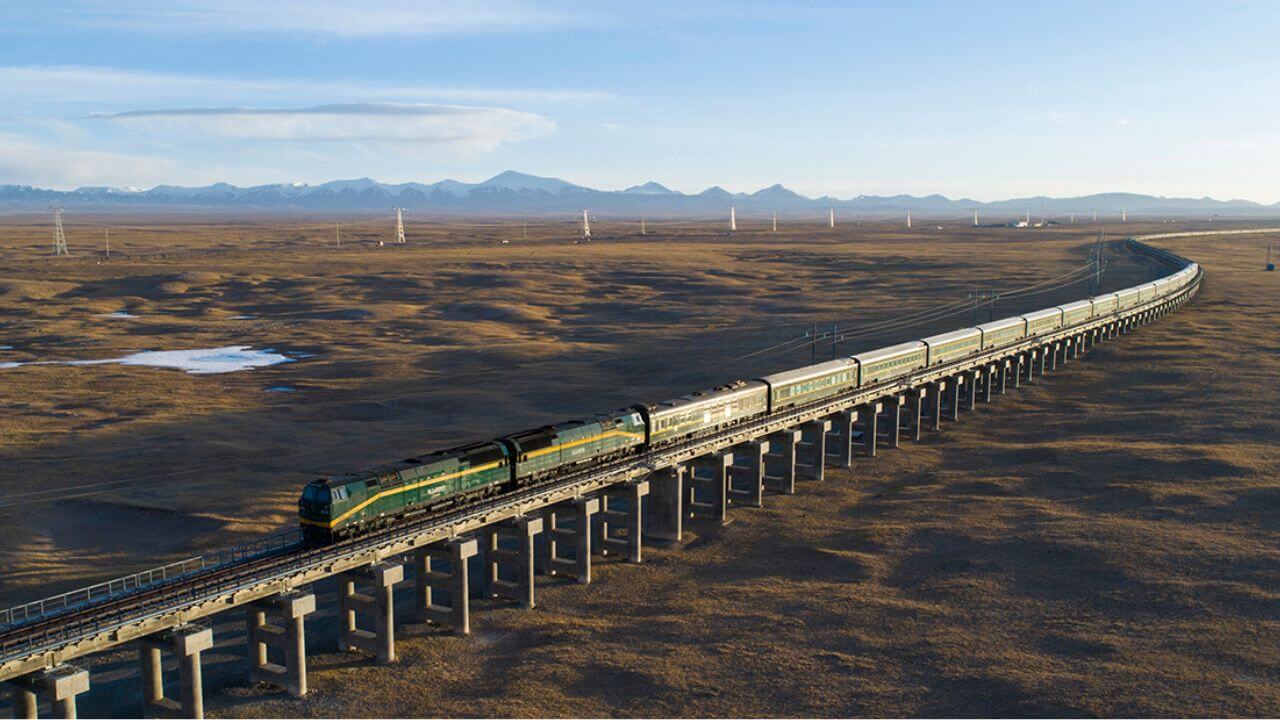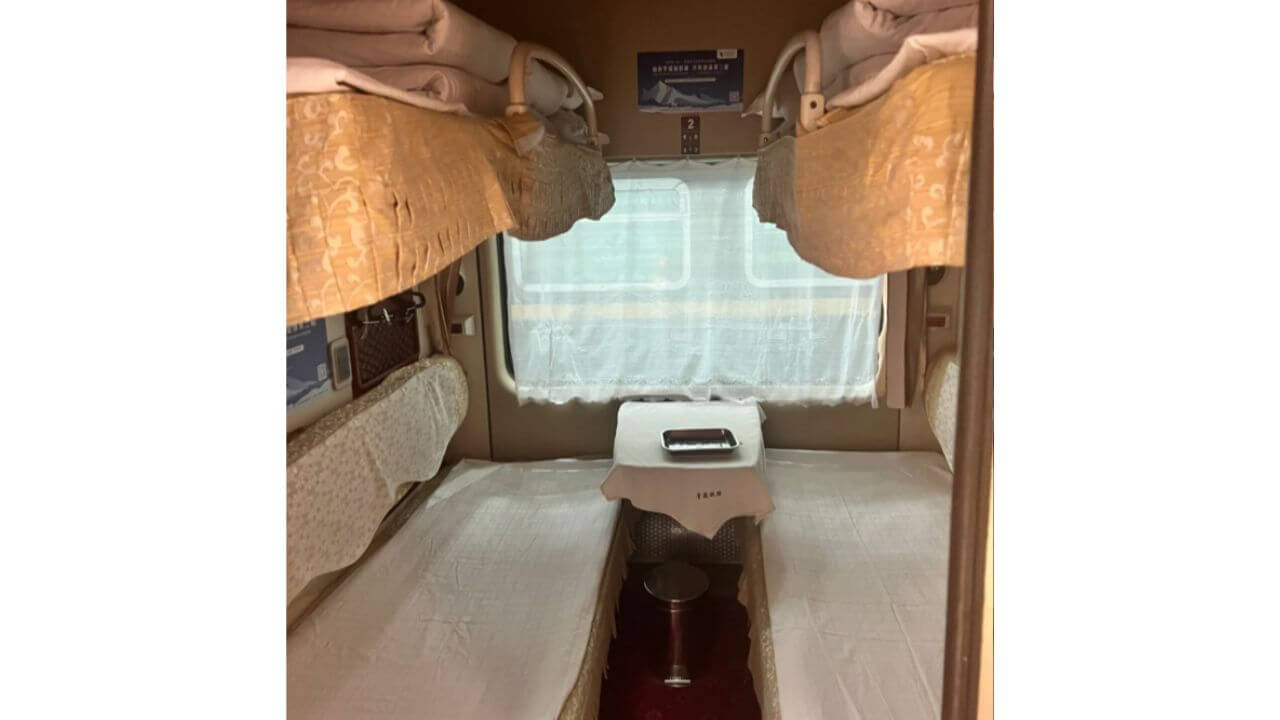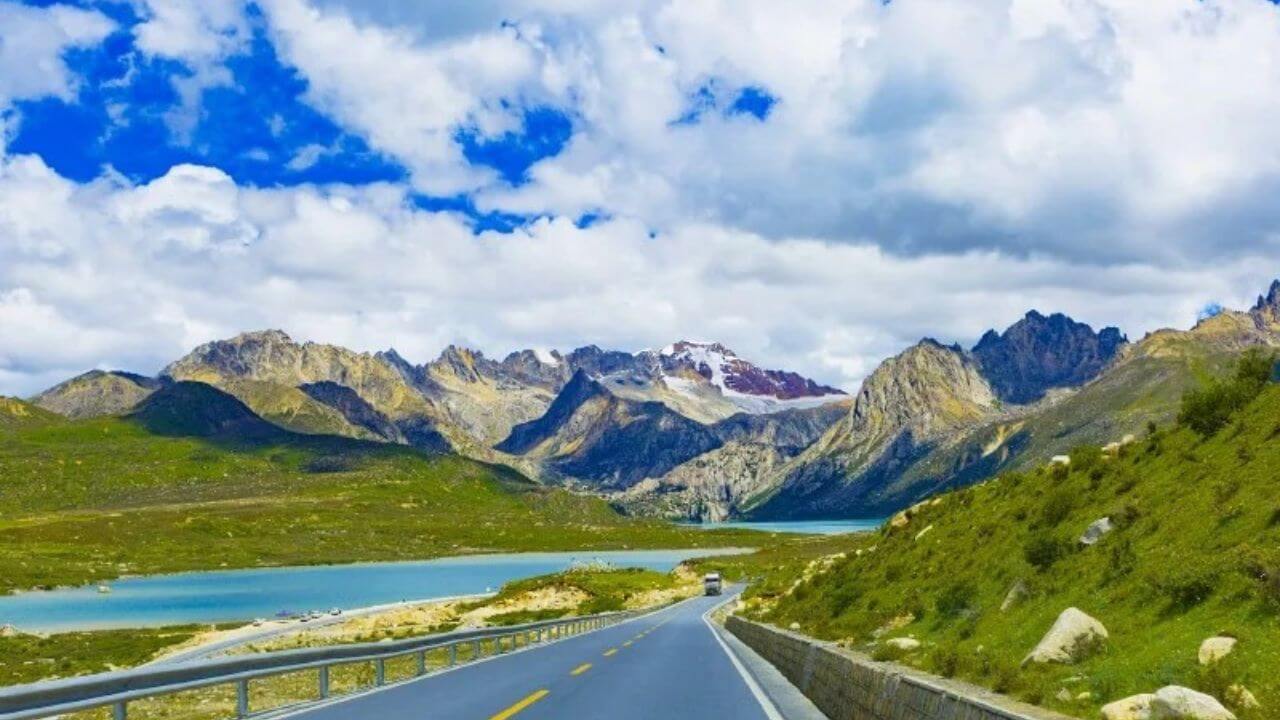Traveling to Tibet involves careful planning due to its remote location and special travel requirements. Here’s a Travel Guide on getting to Tibet by train, air, and road, as well as transportation options within Tibet.

“Traveling to Tibet by train is a journey through the heavens, where each mile unfolds the breathtaking beauty of the Roof of the World.”
Getting to Tibet with Qinghai-Tibet Railway
The train from Beijing to Lhasa, known as the Qinghai-Tibet Railway, is a marvel of modern engineering and one of the most scenic train journeys in the world. The journey spans approximately 40-48 hours, covering over 3,700 kilometers. This railway connects the vibrant capital of China with the mystical city of Lhasa, traversing diverse landscapes and challenging terrains.
What you will see during your train journey
Tibetan Plateau: The train travels across the vast expanse of the Tibetan Plateau, offering stunning views of snow-capped peaks, pristine lakes, and remote villages.
Kunlun Mountains: The route includes a spectacular passage through the Kunlun Mountains, known for their dramatic scenery and rugged beauty.
Tanggula Pass: At 5,072 meters (16,640 feet), the Tanggula Pass is the highest point on the railway, providing breathtaking views of the surrounding mountains and a unique high-altitude experience.
Qinghai Lake: As the train travels through Qinghai Province, passengers can enjoy views of Qinghai Lake, the largest saltwater lake in China, known for its vibrant blue waters and birdlife.
Hoh Xil Nature Reserve: This reserve is home to a variety of wildlife, including the endangered Tibetan antelope. Passengers may catch glimpses of these animals in their natural habitat.

Train Facilities
The Qinghai-Tibet train is equipped with modern facilities to ensure a comfortable journey for passengers, even at high altitudes.
Cabin Types:
- Soft Sleeper: These cabins offer the highest level of comfort with four berths per compartment. Each compartment has a lockable door for privacy, soft bedding, and ample storage space.
- Hard Sleeper: These cabins have six berths per compartment, offering a more economical option. While less private than soft sleepers, they still provide a comfortable sleeping arrangement with bedding.
- Seats: There are also hard seat options available, which are the most budget-friendly but least comfortable for the long journey.
Oxygen Supply:
- Cabin Pressurization: The cabins are partially pressurized to help passengers acclimatize to the high altitude gradually.
- Oxygen Outlets: Each cabin is equipped with oxygen outlets, and individual oxygen masks are available to passengers if needed. This helps mitigate the effects of altitude sickness.
- Emergency Oxygen Supply: In addition to the regular oxygen outlets, the train has an emergency oxygen supply system and altitude sickness medical kits on board.
Dining and Refreshments:
- Dining Car: The train has a dining car that serves a variety of Chinese and Tibetan dishes. Passengers can enjoy meals while taking in the scenic views.
- Snack Trolleys: Snack trolleys pass through the carriages offering drinks, snacks, and light meals for purchase.
Restrooms and Showers:
- Restrooms: The train has both Western-style and squat toilets, which are cleaned regularly.
- Showers: Soft sleeper carriages often include shared shower facilities for passengers.
Entertainment and Connectivity:
- Windows: Large windows in each cabin allow passengers to fully appreciate the stunning landscapes.
- Power Outlets: Each berth has power outlets for charging electronic devices.
- Wi-Fi: Limited Wi-Fi service is available, but the connection can be intermittent due to the remote areas the train travels through.

Tickets
Tickets for the Beijing to Lhasa train can be booked online or through travel agencies. It is advisable to book well in advance, especially during peak travel seasons such as summer and major Chinese holidays, as tickets sell out quickly. There are different classes of tickets available, including soft sleeper, hard sleeper, and hard seat, each offering a different level of comfort and pricing.
When you are getting to Tibet, I recommend to choose soft sleeper cabin, because its long journey, and its advisable to be comfortable during traveling.
The ticket price for soft sleeper is ¥1,144 ( $158 US), and for hard sleeper is ¥720 (around $100 US), for one way. Also, buy tickets at least two months in advance, the train is crowded and its hard to get a ticket in last moment. You can purchase ticket on yourown, or your trave lagency can to that on your behalf.
When you will arrived in Lhasa, you tour guide will meet there with your rent vehicle, but if you decide to go with taxi it will cost you around ¥30 to Lhasa’s old town.
Traveling to Tibet by train from Beijing has many advantages, and one of them is gradually acclimatization.
Geting to Tibet by Air
Flying to Tibet is a convenient and time-efficient option for many travelers. Here’s a detailed guide to flying into Tibet:
Major Airports
Lhasa Gonggar Airport (LXA): The main entry point for air travel to Tibet, Lhasa Gonggar Airport is situated about 60 kilometers (37 miles) from Lhasa city center. It is the largest and busiest airport in Tibet, offering a range of facilities for travelers. Shuttle buses and taxis are available to transport passengers to the city. Your tour guide will meet you in your rented vehicle. If you choose taxi you need to pay ¥300 to Lhasa.
Nyingchi Mainling Airport (LZY): Located in the southeast of Tibet, Nyingchi Mainling Airport is known for its picturesque surroundings. The airport is closer to sea level compared to other Tibetan airports, making it a good entry point for those concerned about altitude sickness. It’s about 2,949 meters (9,675 feet) above sea level.
Shigatse Peace Airport (RKZ): Situated in Shigatse, the second-largest city in Tibet, this airport serves as a gateway for travelers heading to Mount Everest and other western Tibet destinations. It is located about 43 kilometers (27 miles) from the city center.

Direct Flights
From Major Chinese Cities: There are numerous direct flights to Lhasa from major cities across China, including:
- Beijing: Multiple daily flights are available, with a flight duration of approximately 4-5 hours.
- Chengdu: Chengdu offers one of the most frequent connections to Lhasa, with flight durations of around 2.5 hours.
- Chongqing: Direct flights from Chongqing take about 2.5-3 hours.
- Xi’an: Flights from Xi’an to Lhasa typically take around 3-4 hours.
- Kunming: The flight duration from Kunming to Lhasa is approximately 3 hours.
From Kathmandu, Nepal: Lhasa is also accessible via direct flights from Kathmandu, the capital of Nepal. This international route takes about 1.5 hours and offers spectacular views of the Himalayas, including Mount Everest, during the flight.
Note: If you decide to fly to Lhasa, then you need to have two to three days to acclimatize and then continue your adventure around this magnificent land.
Please read about health and safety for Tibet, here you can learn more about altitude sickness and how to avoid them,
Going to Tibet Overland (Bus, Cars)
Overland Routes: Getting to Tibet by road it can be an adventurous option. Major routes include:
- Sichuan-Tibet Highway: Connecting Chengdu in Sichuan Province to Lhasa, known for its scenic beauty and challenging terrain.
- Yunnan-Tibet Highway: Starting from Kunming in Yunnan Province and passing through diverse landscapes.
- Qinghai-Tibet Highway: Starting from Xining in Qinghai Province, this is the most popular and well-maintained route.
Buses and Cars: Regular bus services are available from cities like Chengdu, although the journey can be long and challenging. Hiring a private car or joining an organized tour can provide more comfort and flexibility.

Entering from Nepal
Friendship Highway: The primary route from Nepal to Tibet is the Friendship Highway, connecting Kathmandu to Lhasa. The journey takes you through the Zhangmu border crossing (recently moved to Gyirong Port after the 2015 earthquake).
Travel Options: You can hire a private vehicle or join a tour group for the overland journey. There are also occasional bus services available.
Transportation in Tibet
Private Vehicles and Tours: Most travelers in Tibet use private cars and tour buses arranged by travel agencies. This is the most convenient and flexible way to explore the region.
Public Buses: Public bus services are available in Lhasa and other major towns, but they are less common in remote areas.
Taxis: Taxis are readily available in Lhasa and can be a convenient option for short trips within the city.
Bicycles and Motorbikes: Renting a bicycle or motorbike is an option for adventurous travelers who want to explore at their own pace.
Trains and Flights: For long-distance travel within Tibet, trains and flights connect major cities and regions, providing quicker alternatives to road travel.
Getting to Tibet is an adventure that starts the moment your journey begins. Whether you fly, enjoying swift and scenic views, or take the train, slowly climbing to the Roof of the World, the trip is as exciting as the destination. Be ready for high altitudes and stunning landscapes as you reach this mystical land. Embrace the rich culture, deep spirituality, and incredible natural beauty of Tibet. Your adventure to the heart of the Himalayas will be unforgettable.

Helen Wang
Travel Advisor & Guide Expert
I started my travel career in 2005 and have since become an expert in Tibet and China’s travel destinations and helping travelers plan unforgettable trips.
For expert travel advice to China or Tibet, feel free to contact me.